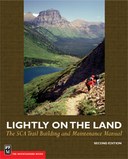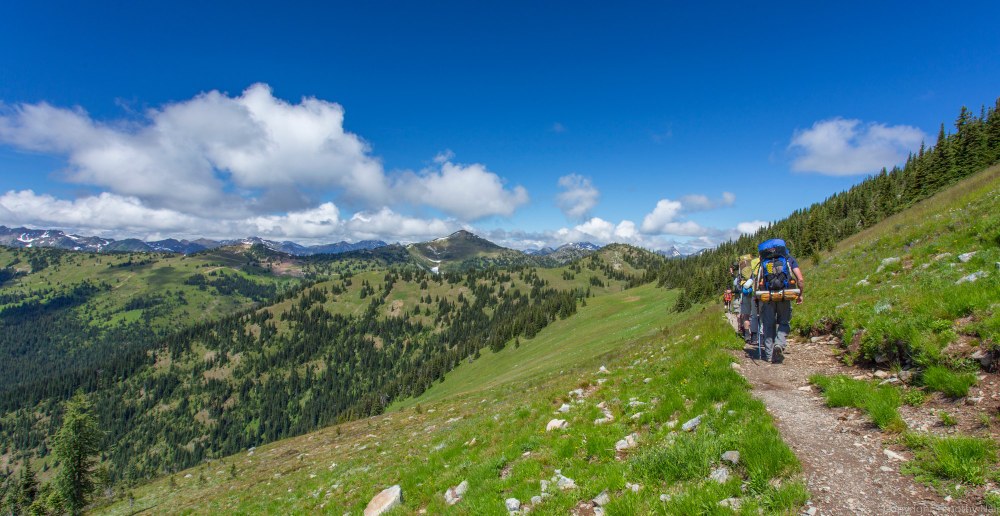
Those of us who build and maintain trails don’t want you to know what we’ve done. We’re eager for you to hear birds, see mountains and forests, feel the wind in your face, and safely reach your destination. We want you to drink in the backcountry so completely that you barely notice the tread rolling beneath your boots.
My colleagues and I began writing a book 25 years ago that explores the secrets behind this Zenlike concept. Published by Mountaineers Books in 1996, Lightly on the Land: The SCA Trail Building and Maintenance Manual reveals the technical magic of the trail crew’s craft. Why does a pathway go where it goes? How can you move boulders through the woods and fit them into staircases and walls? What’s involved in clearing trails of fallen trees in wilderness areas where power tools are banned? Flip through the book’s 308 pages and you’ll never hike again without being aware of what’s underfoot.
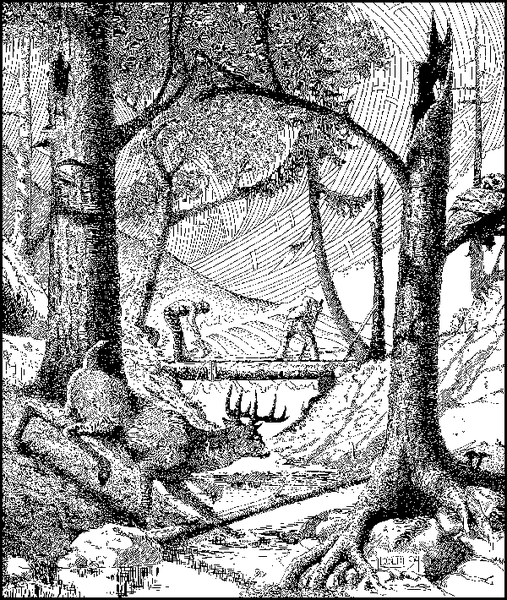 Capturing the magic of trail work. Illustration by SCA crew leader Peter Lucchetti.
Capturing the magic of trail work. Illustration by SCA crew leader Peter Lucchetti.
Lightly on the Land has long helped conservation crews master skills they need to care for our public lands. Louie Coglas, a 32- year Mountaineers member and stewardship leader, gives the book to students enrolled in his annual trail maintenance class, saying, “The writing and drawings are an inspiration for those learning the craft.”
As an educational tool, the book supports The Mountaineers mission to help people explore, conserve, learn about, and enjoy the lands and waters of the Pacific Northwest and beyond. That’s especially true when “beyond” includes Siberia, Moldova, and the Russian Far East.
Education of a trail dog
My own journey as a conservationist began with college summers in northern New Mexico leading backcountry work crews at Philmont Scout Ranch, a national high adventure base of the Boy Scouts of America. It was a great way to learn the basics of trail construction and maintenance, and to develop an appreciation for what goes into the design and care of sustainable pathways.
A few years later I solo-hiked the Appalachian Trail and then was drawn to the Northwest in search of bigger mountains, bigger water, and people eager to explore both. I found them all, and was soon leading month-long Student Conservation Association (SCA) crews of high school-aged volunteers improving trails in national parks and forests.
The SCA had its start in 1957 in Olympic and Grand Teton National Parks. By the time I found them in the early 1980s, crews were serving in many other places as well, but their technical skills were uneven at best.
"Flip through the book’s 308 pages and you’ll never hike again without being aware of what’s underfoot."
A group of us launched the Wilderness Work Skills Program to better train SCA leaders and to share ideas with other organizations and land management agencies. The initial project in 1985 was the rehabilitation of the Tower Falls Trail in Yellowstone National Park. Participants rotated through hands-on stations focusing on rock work, timber construction, tread and drainage, revegetation, and survey and design. In all, we did six one-week trainings.
Encouraged by that Yellowstone success, we took the show on the road. Our rolling headquarters was named Beluga, an old delivery truck painted white and outfitted with the stove from a Mexican restaurant to serve as a field kitchen. Our 1962 Ford Econoline van full of tools had so much automotive putty holding it together it became known as Bondo.
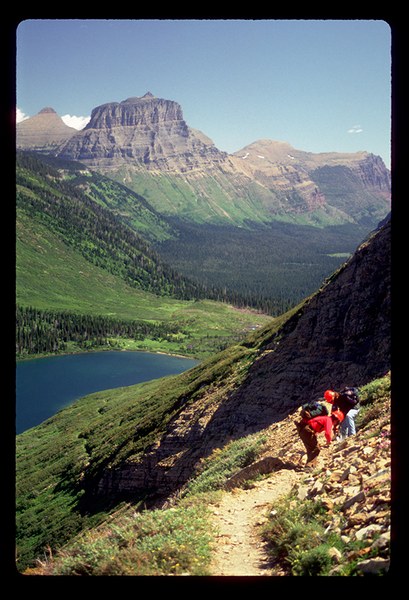 Working on a trail at Gunsight Pass in Glacier National Park. Photo courtesy of the Student Conservation Association.
Working on a trail at Gunsight Pass in Glacier National Park. Photo courtesy of the Student Conservation Association.
We put on programs from coast to coast and soon discovered there were plenty of trails experts out there who knew a lot more about managing pathways in their regions than we did. Our role quickly changed from being instructors to that of facilitators as we encouraged everyone attending Work Skills courses to share their expertise.
"Our 1962 Ford Econoline van full of tools had so much automotive putty holding it together it became known as Bondo."
And share they did. Sierra trail crews taught us how to shape granite into nearly seamless staircases and retaining walls. Pacific Northwest crews with crosscuts and chisels engaged us in crafting remarkable bridges from cedar and fir. Vegetation specialists in the Southwest introduced us to the restoration of damaged arid regions. Up and down the Appalachians we witnessed solutions that had been worked out by crews pounding away at trail problems for more than a century.
We also discovered that, like ourselves, most people engaged in backcountry stewardship had honed their skills by working alongside seasoned veterans. It was a tradition that could be traced to the 1930s and the Civilian Conservation Corps of the Great Depression, when more than three million young men, each working for a dollar a day, had constructed the infrastructure of many state and national parks and forests. Much of what they built is intact today, and much of the craftsmanship they used is still considered state-of-the-art.
Spreading the word
As our Work Skills travels continued into the 1990s, we realized we were accumulating a tremendous body of knowledge that was not written down in a format available to the general public. Manuals did exist, but most were regionally focused or laden with the technical jargon of agencies. We thought we could put together a book presenting a standard approach to trail work and site restoration that could be applied anywhere. The book would also celebrate what was special about local approaches to backcountry challenges.
Encouraged by Jay Satz, SCA’s then vice president for program, we pulled together all we had learned into a draft of Lightly on the Land. The title came from my Philmont trails mentor Rod Replogle of the US Forest Service. While teaching us how to survey route locations, he stressed that a trail should hug the contours of the landscape so lightly that it would all but disappear from a hiker’s awareness.
We distributed copies to crew leaders for a season of field use and asked for their input. Forest Service crosscut saw expert David Michaels’ feedback was typical of many of the drafts we received. The white spaces in the margins of every page were crammed with his tight, penciled observations, adding richness and detail to the skills we described.
We also circulated the manuscript in search of a publisher and heard from Greg Ball, then a member of The Mountaineers publications committee and founder and director of the volunteer trail maintenance program for the Washington Trails Association. “I was in bed reading about stump removal, and started to laugh out loud,” he told us. He felt that any book that could amuse him with that subject so late at night deserved to be in print.
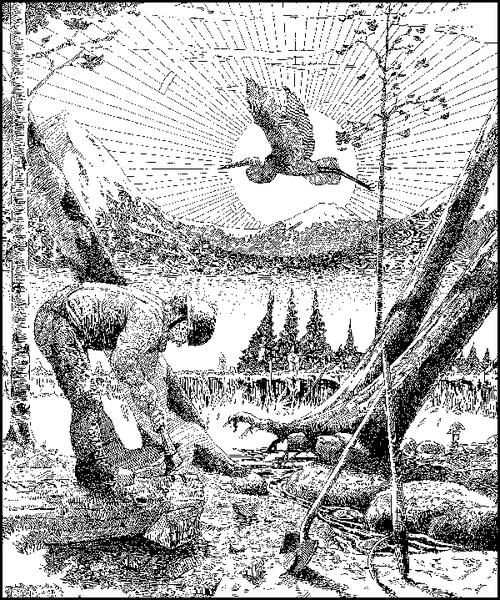 Cutting a flat surface onto a log for bridge construction. Illustration by SCA crew leader Peter Lucchetti.
Cutting a flat surface onto a log for bridge construction. Illustration by SCA crew leader Peter Lucchetti.
Even with Greg’s support, Mountaineers Books was concerned the volume wouldn’t sell. Eventually the publications committee decided the content was so well aligned with the organization’s beliefs that The Mountaineers took a leap of faith with Lightly on the Land, and it rolled off the press. That was two decades and more than 18,000 copies ago. The book is in its second edition and moving toward a third.
“The tribulations of stump removal will try your patience as do few other tasks in trail work. When you match your intelligence to that of a stump, though, chances are better than even that you will be at a slight advantage.” -Lightly on the Land
Going global
Who has been buying all those copies? For starters, there are hikers who want to know what goes into a well-constructed set of backcountry stairs, a rock retaining wall built without mortar, or switchbacks that have been around for years without suffering from erosion.
Secondly, the budgets of most forest and park agencies continue to shrink, reducing the numbers of paid trail maintenance crews. Land managers have increasingly turned to volunteers to get work done, providing them with Lightly on the Land for essential insights into ways to complete projects.
Many organizations have added the book to their libraries, too. EarthCorps, Washington Trails Association, Northwest Youth Corps, the Pacific Crest Trail Conference, and others consider it a textbook for what they do. At Philmont Scout Ranch, the conservation department has grown to more than a hundred well-trained seasonal staff, many carrying Lightly on the Land in their backpacks.
The reach of the book has also become global. Veteran instructors from the old SCA Work Skills Program have been helping develop the abilities of the Great Baikal Trail Association (GBTA) and leaving copies of Lightly on the Land as guidebooks.
GBTA invites international volunteers to join crews working on public lands surrounding Siberia’s Lake Baikal. Set in a spectacular mountain watershed, the lake is a mile deep, 400 miles long, and holds twenty percent of the world’s fresh water. During Soviet times few people were allowed into Baikal’s five national parks and reserves, so trail networks weren’t needed.
Now Russian land managers are eager to meet the demands of local hikers and attract foreign eco-tourists, and for that they need trails. The agencies have found GBTA’s crews to be indispensable. Traditionally, in this part of the world the word “volunteer” meant “what the government tells you to do on weekends,” but it’s now worn as a badge of honor by GBTA leaders and crew members alike.
The stewardship model created by GBTA is spreading to parks in the Russian Far East and other parts of the country, creating a new generation of conservation leaders who realize that hands-on efforts can make a real difference. With the blessing of Mountaineers Books, our Siberian friends are preparing a Russian translation of Lightly on the Land.
Last autumn I traveled with several US Forest Service trails experts to the former Soviet republics of Georgia and Moldova to evaluate trail networks and provide training for agency leaders and members of nonprofit trails organizations. Helen Cherullo, publisher of Mountaineers Books, sent a dozen copies of Lightly on the Land with us. The books proved to be pure gold in supporting our teachings. We carefully selected who would receive each copy so that the volumes could be loaned out to people with an immediate need and then passed on to the next leaders.
Among those we met in Georgia were members of the Trans Caucasus Trail, a non-profit Georgian group hosting volunteer crews to develop a hiking trail from the Black Sea to the Caspian Sea through the Caucasus Mountains. Paul Stevens, TCT’s founder, told us they had learned most of what they know about trail work from a dog-eared copy of Lightly on the Land he had found on a trip to America.
Perhaps that is the greatest compliment we and Mountaineers Books can receive – that Lightly on the Land is being used so much that the books’ covers have become tattered and the pages worn as the knowledge of backcountry work skills continues to be shared.
Grab a copy of Lightly on the Land and see for yourself. It will forever change how you look at the trails you travel. It might also encourage you to join a volunteer trail crew, roll up your sleeves, and have a great time mastering a few work skills as you give back to the backcountry that has given so much joy to you.
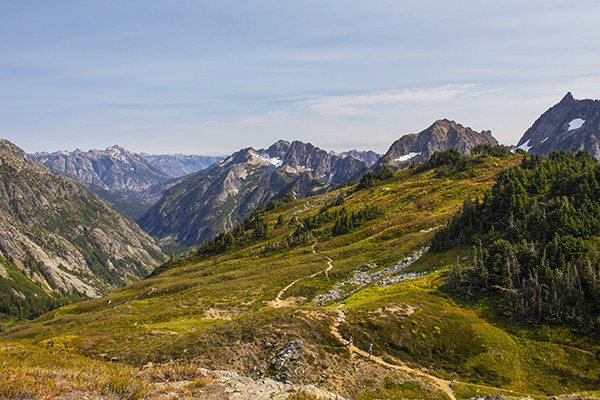 Hikers on Cascade Pass. Photo by Tim Nair.
Hikers on Cascade Pass. Photo by Tim Nair.
Want to help out yourself? Sign up for one of our stewardship activities today.
This article originally appeared in our Fall 2019 issue of Mountaineer Magazine. To view the original article in magazine form and read more stories from our publication, click here.
Add a comment
Log in to add comments.Love this book. When the Everett Branch puts on trail maintenance classes we give this book to the students
 Bob Birkby
Bob Birkby
